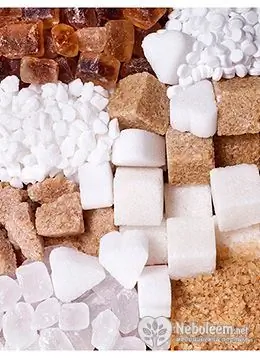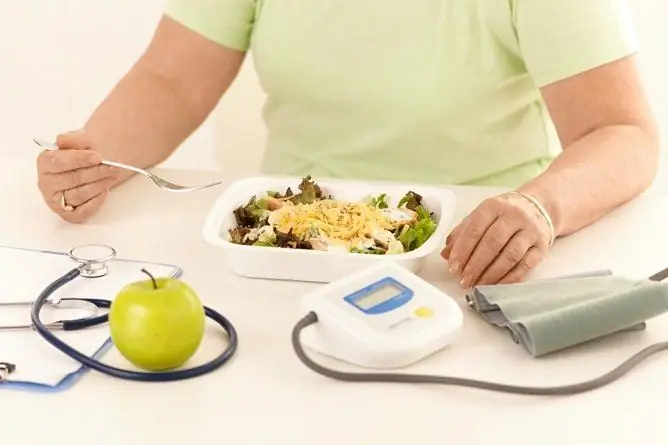- Author Rachel Wainwright [email protected].
- Public 2023-12-15 07:39.
- Last modified 2025-11-02 20:14.
Calorie sugar

Sugar is the generic name for a class of sweet-tasting chemicals, most of which are used in cooking. It is a carbohydrate made up of carbon, hydrogen and oxygen. Chemically different substances can have a sweet taste, but they are not classified as sugars, some of them are used as sugar substitutes, their caloric content is much lower, which allows diabetics to use these sweeteners.
There are different types of sugars obtained from different sources. Simple sugars are called monosaccharides and include glucose (also known as dextrose), fructose, and galactose. Granulated sugar, the most commonly used food, is a disaccharide that is hydrolyzed to fructose and glucose in the body.
Sugar, which is high in calories, is found in the fibers of most plants, but only sugar cane and sugar beets are present in sufficient concentration for effective extraction. Sugarcane is a giant herb that has been cultivated in the tropical climate of the Far East since ancient times. Sugar beet is a root vegetable cultivated in cooler climates.
Most of the studies that have been conducted confirm that eating a high-sugar diet is detrimental to human health. Such a diet leads to obesity and is often the cause of diabetes mellitus, cardiovascular disease, dementia, macular degeneration and tooth decay.
The effect of sugar on the human body
With its high calorie content, sugar provides the body with instant energy, which, however, is not enough for a long time. When it enters the bloodstream, it is converted to glucose, which is the simplest form of sugar. The glucose is then absorbed by the cells of the body and energy is produced.
People suffering from low blood pressure are advised to consume a little sugar several times a day, which is quite high in calories, as it leads to a gradual increase in blood pressure.
The human brain cannot function effectively without sugar. With a complete absence in the diet or with excessive consumption of this product, a temporary inability of the brain to perceive and process information received from the external environment may occur.
There is a widespread belief that a sugar-rich diet leads to hyperactivity in children, but studies have disproved this assumption, since most of the control groups that took part in the experiments did not find much change in the behavior of children.
Calorie content of sugar: nutritional and energy value of the product
The calorie content of sugar is quite high, so this product is not used in almost any diet, however, when consumed in moderation, it does not harm the figure.
Nutritional value and caloric content of sugar per 100 g is:
- Lipids - 0 g;
- Saturated Fat - 0 g;
- Monounsaturated fatty acids - 0 g;
- Cholesterol - 0 mg;
- Sodium - 1 mg;
- Potassium - 2 mg;
- Calorie content of sugar - 387 kcal;
- Carbohydrates - 100 g;
- Dietary fiber - 0 g;
- Vitamin C - 0 mg;
- Calcium - 1 mg;
- Vitamin B6 - 0 mg;
- Magnesium - 0 mg.
In order to determine how many calories are in tea with sugar, it is necessary to add the calorie content corresponding to the number of tablespoons of sugar added to the drink to the calorie content of the tea, which depends on the strength of the drink and averages 10 kcal per 250 ml, regardless of the type of tea. So, for example, if three tablespoons of sugar are added to tea and taking into account that one teaspoon of sugar contains 34.83 kcal of calories, one cup of such tea will have a caloric value of 115 kcal. One tablespoon of sugar contains 68 to 93 calories.
Caloric content of sugar: diet for weight loss

It's no secret that excessive consumption of salt and sugar, which are high in calories, in the daily diet can be detrimental to human health. Reducing salt and sugar in your diet can be challenging, as foods without these additives often become tasteless. A diet without salt and sugar should not start abruptly, it is better to gradually reduce the use of these foods and replace them with others that are safer for the health of the body. Sugar can be an excellent substitute for fruits and berries, as well as a natural sweetener - stevia; instead of salt, dry ginger and garlic, nutmeg or cinnamon can be added to food.
An approximate menu for a diet without salt and sugar, which is high in calories, is as follows:
- Day 1: Breakfast - one orange, one boiled egg and a glass of low-fat yogurt. Lunch - grilled beef steak without oil, stewed zucchini and bell peppers. Dinner - boiled tuna fillet with mushrooms;
- Day 2: Breakfast - two ripe pears and muesli with 1.5% milk. Lunch - boiled chicken fillet and a quarter of raw carrots. Dinner - 300 g of boiled shrimp and 200 g of fresh green peas;
- Day 3: Breakfast - muesli and natural yoghurt. Lunch - vegetable soup and stewed cabbage with mushrooms and carrots. Dinner - roast beef with vegetables and rice;
- Day 4: breakfast - an apple, a pear, and no matter how many calories there are in tea with sugar, a glass of tea with 1 tsp. Sahara. Lunch - two hard-boiled eggs and baked champignons with onions. Dinner - boiled chicken fillet, a slice of hard cheese and boiled cauliflower with broccoli and carrots;
- Day 5: Breakfast - half a grapefruit and tea without sugar, which is high in calories. Lunch - two grated raw carrots with lemon juice. Dinner - 200 g of boiled tuna fillet;
- Day 6: Breakfast - low-fat natural yogurt. Lunch - omelet with mushrooms and corn, a few strawberries and a banana smoothie. Dinner - 200 g of boiled chicken fillet;
- Day 7: Breakfast - oatmeal. Lunch - vegetable soup. Dinner - beef steak and vegetable salad with herbs.
You can adjust the diet on such a diet, in which, due to the negative effect on the body and high calorie content, sugar and salt are excluded, you can independently, it is enough to establish a diet.
Observing this diet, it is necessary to eat food every 2-3 hours, since it has long been proven that if you eat 5-6 times a day, the metabolism is accelerated, which is extremely beneficial for the health of the body and promotes weight loss, and is also necessary for the prevention of diseases Gastrointestinal tract.
The first meal should be taken before 12 noon, and dinner should be 4-5 hours before bedtime. A very important principle of the diet is to consume three times a day in small quantities during snacks of any protein food (cottage cheese, legumes or meat). It is forbidden to salt food and only once in tea you can add a spoonful of sugar, in which there are not so few calories. The duration of the diet is one week. It will be difficult to comply with it at the initial stage, but over time you can get used to such a diet, and even after such a diet is over and a person switches to a diet with sugar and salt, the use of these products will not be as high as before diet.
Found a mistake in the text? Select it and press Ctrl + Enter.






